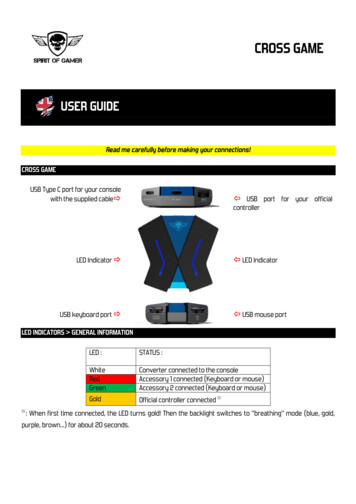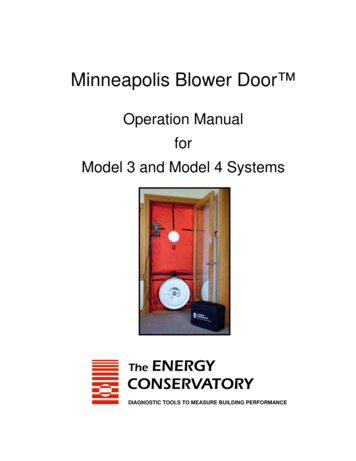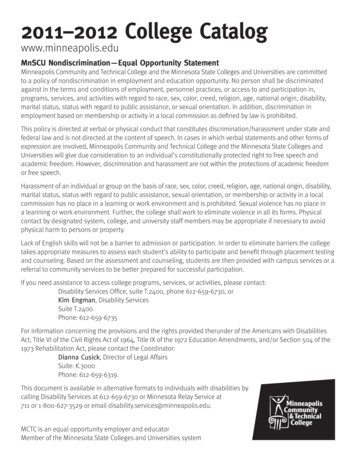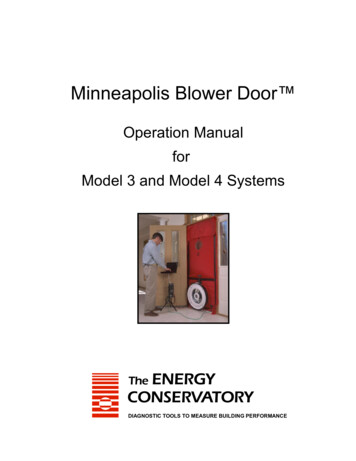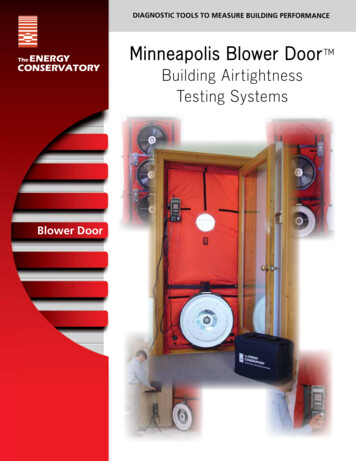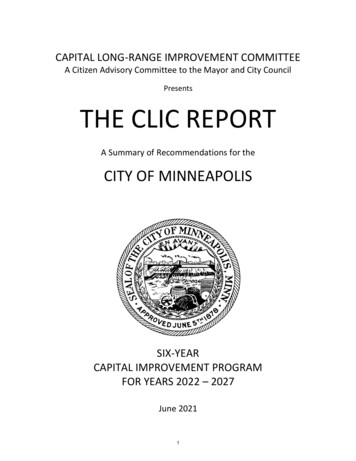
Transcription
CAPITAL LONG-RANGE IMPROVEMENT COMMITTEEA Citizen Advisory Committee to the Mayor and City CouncilPresentsTHE CLIC REPORTA Summary of Recommendations for theCITY OF MINNEAPOLISSIX-YEARCAPITAL IMPROVEMENT PROGRAMFOR YEARS 2022 – 2027June 20211
CAPITAL LONG-RANGE IMPROVEMENT COMMITTEEJuly 5, 2021Honorable Jacob Frey, Mayor of MinneapolisCity Council President Lisa Bender and Council Members3rd Floor – Municipal Building, 350 South Fifth StreetMinneapolis, Minnesota 55415Mayor Frey, City Council President Bender, and City Council Members:I am pleased to submit on behalf of the Capital Long-Range Improvement Committee (“CLIC”) members the 2021 CLIC Report for theCity of Minneapolis. The report includes the Committee’s financial and narrative comments as recommendations for your consideration,and to assist elected policy makers in their deliberations and adoption of the City’s Six-Year Capital Improvement Program (CIP) forYears 2022-2027. Due to the declared local health pandemic (COVID-19), the 2021 CLIC process again was conducted virtually, usingtechnology for remote participation of members and city staff as permitted under Minnesota Statutes § 13D.021. Staff and CLICmembers all stepped up their game to make the process work and meet the challenges -- Finance and Property Services, the CityClerk’s office, proposing departments and boards, along with interested members of the public.CLIC members met 17 times from March 31-June 30: orientation session; two public input and Q&A sessions; Joint Public Hearing withthe Minneapolis Planning Commission; 13 regular meetings. CLIC members reviewed 129 capital budget requests and rated 123totaling 1.366 billion for 2022-2027. The highest score was 238 (SA001 – Sanitary Sewers) of possible 300; the lowest score was 101(MBC15 – Elevator 12 Modernization). The CLIC membership roster, process overview, and committee comments appear in the front ofthe report to give context to the financial funding recommendations that follow. The joint public hearing transcript and several residents’submissions appears in the report. CLIC is recommending funding for 103 capital budget requests totaling 1.103 billion in the 6-yearCIP.Several key issues, priorities, or highlighted project comments are excerpted below from the 2021 CLIC process: General: CLIC asks the Mayor and City Council to include it in future review of capital infrastructure investments resulting fromthe unprecedented infusion of federal funds from the American Rescue Plan Act of 2021. CLIC continues to support enhancedpublic engagement using some form of Participatory Budgeting and transparency by ensuring Public Works’ municipalwebsites don’t prioritize style over substance. CLIC looks to see more proposals addressing the climate emergency, and issuggesting renewal of a program for reforestation of public sector properties.CLIC was briefed on the City’s updated Strategic and Racial Equity Action Plan during portions of two meetings, and has setup an ad hoc committee to work with staff to include more information in onboarding for members in 2022. In addition, therevised 2021 CLIC Guidelines included a Qualitative Criteria rating section for Equity (0 to 25 points).Transportation TF: CLIC recommends the City help residents understand new procedures when transitional traffic safetyimprovements are implemented to improve pedestrian and multi-modal users. CLIC supports strong funding and ongoingassessment and rehabilitation for street paving, bridges, off-street recreation and commuter trails, as well as funding sidewalkgaps. In response to resident input, CLIC requests that Water Treatment & Distribution Services remedy diminished waterquality (rust, sediment) issues experienced by consumers in proximity of the 447 dead-end-water mains in the system.Human Development TF: CLIC recommends the City resolve the strategic direction for providing public safety beforeundertaking the over 57 million in capital projects requested in this category. CLIC sees a “moment of opportunity” to expandon existing City goals for renewable energy in the capital program. CLIC registers its disagreement with the recent CityCouncil decision to suspend 2nd-phase development of the long-planned Hiawatha Public Works complex.The CLIC Executive Committee will meet with Mayor Frey and key staff members virtually to deliver the formal recommendations for2022-2027. The CLIC Committee stand ready to review concerns or questions about its recommendations with all electedpolicymakers. CLIC’s Executive Committee leadership consists of Vice Chair Willie Bridges, and Task Force leaders John Bernstein,Eric Won, Katie Jones, and Jocelyn Beard. Please address questions to: Jeff Strand@msn.com or (612) 710-6147, or to AmeliaCruver, Budget Director, at Amelia.Cruver@minneapolismn.gov or (612) 673-5405.Sincerely,J L StrandJeffrey L. StrandCLIC Chair 2021-2022Pronouns: He/Him/They2
TABLE OF CONTENTSIntroduction to the CLIC ProcessCLIC MembershipCLIC Executive CommitteeCity of Minneapolis Staff Support2021 CLIC General Comments2021 Human Development Task Force Comments2021 Transportation Task Force CommentsCapital Budget Summary – Department Requested BudgetCapital Budget Summary – CLIC Recommended BudgetSix-Year Capital Funding Summary – Department Requested BudgetSix-Year Capital Funding Summary – CLIC Recommended BudgetSix-Year Capital Investment Allocation – CLIC RecommendedPublic Works Department Breakdown2022 Bond Redemption Levy for Capital ProgramNet Debt Bond Allocation – Department Requested BudgetNet Debt Bond Allocation – CLIC Recommended BudgetCapital Budget Detail for Funded ProjectsMiscellaneous ProjectsMunicipal Building CommissionPark BoardPublic Grounds & FacilitiesPublic WorksActive MobilityBike-Ped ProjectsBridgesFleetSanitary SewersSidewalksStorm SewersStreet PavingTraffic Control & Street LightingWater InfrastructureParkingCLIC Comprehensive Project RatingsCLIC Ratings by Commission/Board/Department2022-2027 Capital Program Descriptions2021 CLIC Capital Guidelines2021 CLIC ScheduleJoint Public Hearing Notice & MinutesGlossary of Capital Terms & 353636363740404142454959686995
Introduction to the CLIC ProcessThe City adopts a six-year capital improvement program (CIP) that is updated annually. Each year, Citydepartments, independent boards, and commissions prepare new and/or modify existing capital budgetrequests (CBRs). The CBRs are then reviewed by the Capital Long-Range Improvement Committee (CLIC)which is a citizen advisory committee to the Mayor and City Council. The CLIC process is facilitated byFinance & Property Services staff.CLIC is comprised of 33 appointed members, including two members per Council Ward and seven atlarge members appointed by the Mayor. The overall committee elects a Chair and Vice Chair. Thecommittee functions with two programmatic task forces of approximately the same number ofmembers. Each task force, “Transportation” and “Human Development”, elects a Chair and Vice Chair.Collectively, these six elected members form the Executive Committee and represent CLIC in meetingswith the Mayor and City Council. The task force members receive and review all CBRs for their programareas as submitted by the various City departments, independent boards and commissions.Departments and boards formally present their requests to CLIC members and answer any questionsthey may have. Task force members then rate all proposals using specific criteria and create a numericalranking for each project. Highest-ranking projects are then balanced against proposed availableresources by year to arrive at a six-year capital improvement program recommendation to the Mayorand City Council.CLIC’s recommendations serve as the starting point from which the Mayor and City Council’s decisionsare made. The Mayor makes recommendations on the capital budget as well as the operating budget.The Council adopts the six-year capital plan simultaneously with the operating budget, althoughappropriation is only adopted for the first year.For the six-year plan covering years 2022-2027, there were 129 CBRs reviewed of which 123 were ratedby CLIC members. The total requested capital budget for the six years was 1.366 billion and CLIC isrecommending funding of 103 CBRs for a total of 1.103 billion.For more specifics on the CLIC process, please review the 2021 CLIC Capital Guidelines toward the endof this report.The CLIC committee appreciates the excellent efforts put forth by staff of the various City departments,the Minneapolis Park and Recreation Board and the Municipal Building Commission in recommendingcapital investments for the City of Minneapolis.4
CLIC MembershipJanuary 1, 2021 - December 31, 2022Council Ward / MayoralAppointing MemberCLIC Member11Kevin ReichKevin ReichJake McCormickDan Miller22Cam GordonCam GordonBeth Toso33Steve FletcherSteve FletcherAmity FosterZakaria Aden44Phillipe CunninghamPhillipe CunninghamJeffrey StrandKitrina Stratton55Jeremiah EllisonJeremiah Ellison66Jamal OsmanJamal OsmanErica MauterThorbjorn Adam77Lisa GoodmanLisa GoodmanJohn BernsteinWilliam Gullickson, Jr.88Andrea JenkinsAndrea JenkinsJames BrownSteve Brandt99Alondra CanoAlondra CanoMatt KazinkaWilliam Graves1010Lisa BenderLisa BenderKatie JonesJonathan Ahn1111Jeremy SchroederJeremy SchroederRisa HustadWillie Bridges1212Andrew JohnsonAndrew JohnsonLuke CunninghamScott Engel1313Linea PalmisanoLinea PalmisanoRichard LaReauKai GudmestadMayorMayorMayorMayorMayorMayorMayorJacob FreyJacob FreyJacob FreyJacob FreyJacob FreyJacob FreyJacob FreyEric WonGeorge MontagueEamonn GallagherSanja DeGarmoDan McConnellTodd SchumanJocelyn Beard5
CLIC Executive CommitteeJanuary 1, 2021 - December 31, 2022Leadership PositionMember NameAppointment ofCLIC ChairCLIC Vice ChairJeffrey StrandWillie BridgesPhillipe Cunningham - Ward 4Jeremy Schroeder - Ward 11Task Forces:Transportation ChairTransportation Vice ChairJohn BernsteinKatie JonesLisa Goodman - Ward 7Lisa Bender - Ward 10Human Development ChairHuman Development Vice ChairEric WonJocelyn BeardMayorMayorCity of Minneapolis Staff Support for the CLIC ProcessName / DepartmentResponsibilityPhone NumberAmelia Cruver / FinanceExecutive ovRobert Harrison / FinanceStaff ovNeal Younghans / FinanceStaff v6Email Address
CAPITAL LONG-RANGE IMPROVEMENT COMMITTEE2022-2027 CAPITAL IMPROVEMENT PROGRAMGeneral CommentsParticipatory Budgeting for MinneapolisCLIC reiterates the recommendation from the 2020 CLIC Report “that the City improvecommunity engagement through implementation of Participatory Budgeting practices, usingthe results of its 2017 review of national procedures and best practices of other jurisdictions.”CLIC has repeatedly made recommendations for participatory capital budgeting programs in2015, 2016, 2017, 2019, and last year.CLIC recognizes as a former mayor noted that the 33-member CLIC body is the citizenengagement component for the capital program. That said, CLIC members find a commonmessage from residents and ratepayers at public information sessions and the PlanningCommission joint public hearing is that the Minneapolis’ capital improvement process does notprovide many avenues for residents to engage upstream in the development of proposals.Many other cities including St. Paul provide some opportunities for residents, neighborhoodand community organizations to identify areas of need for capital improvement programmingto be considered by the appropriate advisory board or commission and elected policy makers.Electrical InfrastructureAs the City pursues greater resilience in the face of climate change, CLIC urges the City to pushand collaborate with the electric utility, Xcel Energy, to bury electrical lines during opportunitiesof road reconstruction. Doing so helps protect that critical infrastructure as weather eventsintensify. We know this is possible as it is already done on downtown projects. CLIC urges theCity to ensure the practice of burying electrical infrastructure occurs throughout the city.Parks FundingAs MPRB moves to accomplish the goals laid out in its 20 Year Neighborhood Parks Plan, CLICwishes to be as knowledgeable and involved in the funding process for parks as possible. Inpursuit of this goal, CLIC would ask that MPRB commit to educating CLIC members about theprocess by which that plan will be accomplished through both city and non-city allocated funds,and particularly the unique funding structure of parks across the city.Climate ChangeCLIC notes that language of the Capital Budget Requests (CBRs) is intended to reflect the valuesof the City. Given that the City has declared a climate emergency via resolution No. 2019R-422we recommend that the language of the CBRs and intention of the projects reflect the urgencyof such resolutions.7
General CommentsRenew Reforestation of Public Sector Properties as part of Climate Action PlanCLIC members request that the City and/or Minneapolis Parks consider renewing a formalcapital budget request for a program with goals similar to the “City Property Reforestation –CTY02” that existed in the Capital Improvement Program from 2014-2017 funded at 150,000annually. CLIC requests more complete data for its 2022 process on the status and health of theurban tree canopy cover (acreage, percentage of land, diversity). CLIC members believe thereare opportunities for reforestation on city-owned facilities, as well as other public sectorproperties both large- and small-scale to provide for increased natural space, supporting urbanagriculture and community gardening sites, facilitating carbon sequestration through treeplantings, and implementing other actions in the City of Minneapolis or Hennepin CountyClimate Action Plans. Reforestation should be guided by intentional tree species selection andplacement that is mindful about avoiding potential future impingement on current andpotential solar collectors for electrical generation, which would lower efficiency and affectreturn on investment.The reforestation program could be funded by continuing the current Park Board levy of 1.2million that has funded the removal of ash trees. That eight-year levy expires after this year butcontinuing it for reforestation would provide a substantial addition to the city's tree canopy.Public Works New Website DesignThe unannounced 2021 redesign of its Transportation and Planning website has been confusingand resulted in significant difficulty researching projects which were previously moreaccessible. It is no longer possible to review past, current and future projects by program andreconstruction year. The photo gallery mix of street, water and sewer projects with a wordsearch function to find a specific project is more difficult to understand what Public Works isdoing and how projects interconnect by year and location. The new project template has nottransferred important documentation previously included on projects and some projectsreviewed by CLIC are yet to be added. Some project status information was incorrectly listedand to date remains uncorrected. A decade of relevant public works information previouslygoogle searchable is no longer linked.This new website design has prioritized style over substance and makes Public Worksoperations less transparent to the public. It is understandable that the Covid-19 pandemic mayhave interfered with a smoother transition. However, Public Works and the City need toprioritize taking corrective actions this year to restore information previously available. We askthat Public Works give CLIC a progress report in 2022.8
General CommentsMonitoring and AccountabilityCLIC believes that performance monitoring and accountability are key success factors inmunicipal capital infrastructure projects. Accountability is maintained through a system offinancial and program controls to ensure that projects are managed within allocated budgetsand are completed within agreed upon timeframes. Where cost overruns are anticipated,corrective actions may be taken to ensure that financial controls are in place into the future.CLIC also continues to believe that performance and impact measures are critical to ensure thatcapital investments are achieving promised outcomes. CLIC encourages the City to adopt apublic facing project management system, including a set of dashboards, which will createtransparency and allow residents and businesses to monitor progress that is being made ineach city capital project. Where projects are delayed, lowered in priority, or eliminated fromthe queue, a dashboard would keep residents informed about projects that directly affect themand their communities.American Jobs Plan ActChapter 35 of the Minneapolis Code of Ordinances establishes the purpose, roles, andresponsibilities of the Capital Long-Range Improvement Committee (CLIC), whose purposesinclude integrating “ the capital planning of the respective jurisdictions with a review of allproposed capital expenditures for both new and existing city infrastructure. “ Additionally,“[t]he city’s capital program should include capital projects of the city council/mayor controldepartments, the Minneapolis Park and Recreation Board, the neighborhood revitalizationprogram, the municipal building commission, and the youth coordinating board and the libraryboard.” Furthermore, “[t]he capital program shall include all sources and uses of financialresources used to acquire, replace, or increase the useful life of the city’s real assets. Estimatesshall be made concerning the operating budget impact associated with each capital project."The CLIC encourages the Mayor and Council to comply with this mandate, both now and intothe future, as Federal and State grants are provided to the City of Minneapolis from andthrough both the American Rescue Plan Act of 2021 and the proposed American JobsPlan Act. Both Acts will fund municipal capital investments of historic proportions, including aprojected 3.5 trillion, nationally, for capital infrastructure spending across the country.Minneapolis is anticipated to receive the largest tranche of capital infrastructure funding in thehistory of our city.For this reason, CLIC would like the Mayor and Council to include the CLIC in the review of allproposed capital expenditures for both new and existing city infrastructure that may resultfrom this unprecedented infusion of Federal funds over coming years. The legal mandate toprovide such analysis and input exists in City ordinance. The CLIC has achieved a notable level oftransparency with the public through its budget review processes and methodologies (whichare a matter of public record) and the CLIC has a record of public engagement andcollaboration, including annual meetings with the City Planning Commission. The CLIC includesrepresentation from throughout the City, including 26 members appointed by City Councilmembers and seven members appointed by the Mayor.9
General CommentsCLIC ProcessRecently, several capital projects that the City has undertaken, or is considering, have not beensubmitted to the CLIC process. The committee strongly rejects the notion that any capitalproject should legitimately not be part of the CLIC process. The new city office building and thecontemplated reconnection of Nicollet Ave. at Lake St. are two examples of this.Chapter 35 of the City Code clearly states that, “The city's capital program should includecapital projects of the city council/mayor controlled departments, the Minneapolis Park andRecreation Board, the neighborhood revitalization program, the municipal buildingcommission .” As the ordinance also makes clear, the funding sources of any capital projectare not relevant as to whether or not a project should be included in the process.Improving CBR Submission QualityThe current capital budget request (CBR) form collects both information that is very useful tothe committee, along with information that is of no use. Understanding that CLIC may not bethe only consumers of this information, the committee would like to see the form streamlined,so that only necessary information is included. This should also allow the submitters to focus onmaking sure that the useful and necessary information is provided as fully and accurately aspossible. To further improve on this goal, CLIC recommends that the finance department offertraining on best practices for completing CBRs.Additionally, in the fall of 2020, an ad hoc subcommittee of CLIC met over several months withthe purpose of recommending changes to the CBR forms that are used by city departments topropose and request funding for new and ongoing capital projects. We strongly urge the Cityfinance department to work with committee members in an effort to determine the best wayto implement those recommendations.Street Infrastructure OrdinanceAs CLIC has continued to comment for the past several years, the committee recognizes theeffort undertaken by the City to find a solution to the difficulties of maintaining the condition ofexisting parks and streets infrastructure at an acceptable level. The Neighborhood Park andStreet Infrastructure ordinance clearly outlines the significant amount of capital that has beencommitted to fund capital projects aimed at maintaining and improving the condition of theseassets. The ordinance specifically earmarks funding for park and street infrastructure for 20years, which began in 2017. As the City approaches the 5th year of this effort, CLIC believes thatit would be useful to measure the results. Specifically, as it relates to streets the committeewould like to know how the overall pavement condition index has been impacted.As a result of the ordinance, this significantly changed and complicated the process CLIC uses toreview and rate projects. Previously, preference was not given to any particular type of project,but rather, each project was simply rated on its own merits. This process had to be modifiedbecause, as required by the ordinance, an additional 8 million, plus inflation adjustments,10
must be spent on park capital projects each year, and an additional 21.2 million, plus inflationadjustments, must be spent on street infrastructure each year.Again this year, the committee had to balance both the bottom‐line net debt bond budget,while also ensuring, to the extent possible, that the requirements for parks and streetsinfrastructure, as defined in the ordinance, were also being met. We commend Public Works forcontinuing to increase the number of paving projects this year, which allowed CLIC to make realchoices between projects, while still ensuring funding requirements were satisfied.Unfortunately, the same cannot be said for the Park Board. Once again this year, the ParkBoard’s requests virtually match the funding that is available. As we have stated previously, thiseffectively removes the committee’s advisory role, and the elected officials’ ability to executeon that advice. This makes the capital budget process much less robust than it should be. Thecommittee again requests that the Park Board submit more projects for each year, so that CLICis able to make real choices.With respect to recommending a balanced budget, the committee took the following approach.We paid the greatest amount of attention to getting the 6-year total reasonably balanced.Secondarily, we tried to balance the near-term years (2022 and 2023) at zero or very close to it.Finally, we allowed the out years to be a bit more out of balance. Part of the reason for thisapproach is that moving funds between years has the effect of changing the timing of whenvarious projects can be started and completed. The committee does not have enoughinformation to know whether those shifts are realistic in terms of actually having the non‐financial resources available for all of the timing changes that result. So, if staging projectsappropriately results in one year being underfunded and another year being overfunded, wefind that acceptable as long as the 6-year period is balanced.In order to facilitate all of the activity described above, a number of non‐paving projects wereeither not funded, or had to be funded at lower levels as funding had to be diverted to streetinfrastructure work to comply with the ordinance. This underscores an unfortunate unintendedconsequence of a highly prescriptive ordinance such as this. It allows very little flexibility tobalance other important capital projects against the requirements of the ordinance. As anexample, streets are rather narrowly defined to mean the surface condition of roadways. Thecommittee was presented with a significant amount of funding requests for bridges. Theseprojects are not counted as part of the streets infrastructure ordinance. As a result, there is anopportunity cost for these and many other projects since compliance with the ordinance isrequired. Deferring capital improvements in other areas, particularly bridges which tend to becostly, will make those projects even more expensive in the future.The committee again recommends that the Mayor and City Council consider introducing moreflexibility to the Neighborhood Park and Street Infrastructure ordinance. This could beaccomplished several different ways: by submitting more projects; expanding definitions of thetypes of projects that qualify; compliance with the funding requirements in 6‐year periodsinstead of annually; expanding the definition of qualified funds; direct amendments to theordinance; or some combination of these. In particular, the committee requests that the Mayorand City Council review and approve the definition of qualified funds.11
Human Development CommentsFLT01 Fuel and Charging StationsCLIC encourages the City to lead in the use of forward-thinking strategies and explore the use ofhydrogen stations to support new alternatively powered vehicles. As noted by CLIC last year,CLIC requests that since gasoline and diesel infrastructure and electric vehicle chargers achieveand address City goals in different ways, fueling and charging projects should be treated asseparate projects such that they can be scored appropriately. As such, CLIC recommends nofunding for any of this work until the projects are separated.MPD04 New 1st Police PrecinctMPD05 4th Police PrecinctPublic SafetyGiven the various efforts currently underway to change how policing and public safety areprovided by the City, CLIC finds it difficult to properly assess, and make recommendations on,major investments relating to the Police Department, such as new buildings, renovations toexisting facilities, and other capital requests. Specifically, the two requests for new precinctbuildings (MPD04/MPD05) and the MPD Training & Wellness Center (PSD23) are seeking a totalof over 57 million for assets that would have useful lives for many decades into the future.This lack of direction is not a new problem. In 2019, in evaluating a request for a new buildingfor the 1st Police Precinct, CLIC requested clearer guidelines on the role and development ofpublic safety in Minneapolis. In 2020, CLIC once more commented that it lacked clear guidanceon the aims and potential transformation of public safety in the city, and for that reason wasunable to meaningfully evaluate the appropriateness of capital projects as compared to citygoals.CLIC strongly recommends that the City resolve the strategic direction for providing publicsafety before requesting funds for, or undertaking, projects such as those noted above.Additionally, the Committee requests that the City also conduct a comprehensive strategicreview, including a complete inventory of all current, and contemplated, future physical assetsfor the Police Department once its strategic direction is clear.We would note the curious absence of any requests or information regarding a replacement forthe 3rd precinct building that was destroyed last year. Given the size of these investments, it iscrucial that CLIC is able to see all of the department’s current and future needscomprehensively. Accordingly, the Committee recommends that such projects be delayed untilthese issues have been satisfied.12
Human Development CommentsWTR18 Water Distribution FacilityPSD21 Hiawatha Training & Recruitment CenterFIR11 Fire Station No. 11CLIC disagrees with the recent City Council decision to suspend second-phase development ofthe Hiawatha Public Works complex. The 1990 master plan to consolidate Public Worksenterprises at this site is intended to improve scattered inefficient and substandard facilitieswith a consolidated campus. Moreover, suspending the implementation of WATER18 (WaterDistribution Facility) will stall development of the proposed FIR11 (Fire Station No. 11), becausewater operations need to vacate the East Yard on E. Hennepin Avenue in order to free the sitefor a replacement for the current substandard Station 11. Halting WTR18 also will block themuch-needed effort to consolidate water maintenance operations on one site. Stalling thereplacement of the substandard East Yard site consigns city workers to remain in an inadequatesite in which welding is done on a creosoted wooden floor in cramped quarters, the onlyconference room is accessible only by a non-ADA compliant stairway, expensive equipment isstored in the hayloft of a 19th Century stable, and there is inadequate inside storage formaintenance vehicles that hold computers and valves that can’t tolerate freezing weather.Halting PSD21 (Hiawatha Training and Recruitment Center) is counterproductive to the needs ofthe East Phillips area because it deprives residents in an area of concentrated poverty to betrained for jobs that pay far in excess of the city’s minimum 15 per hour standard.CLIC recognizes that residents of the area justifiably feel they are exposed
Introduction to the CLIC Process . The City adopts a six-year capital improvement program (CIP) that is updated annually. Each year, City departments, independent boards, and commissions prepare new and/or modify existing capital budget requests (CBRs). The CBRs are then reviewed by the Capital Long-Range Improvement Committee (CLIC)



